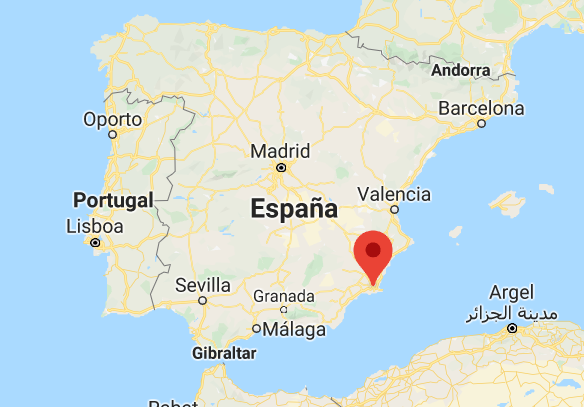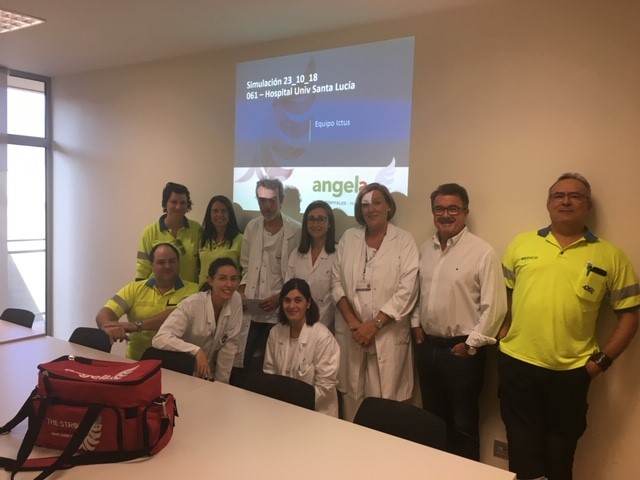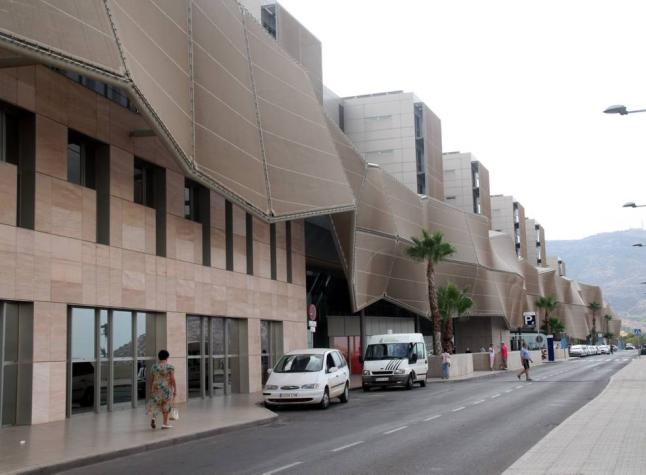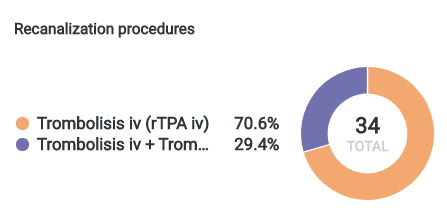Located in the port city of Cartagena, southeast of Spain, Hospital Universitario Santa Lucía serves approximately 279,000 inhabitants of the Murcia region. They first joined the Angels Community at the beginning of the year 2018, after the Angels consultant reached them as part of the regional plan.

At that time, there was not enough data to really measure the efficiency of the management of stroke patients in the hospital and coordination with EMS services from the region was extremely limited. We had estimated the door-to-needle time to be around 60 – 70 minutes, however there was no official registry to refer to.
Led by Dr. Jose Antonio Pérez Vicente, Dra. Maria Dolores Ortega and Dra. Cristina Sánchez Vizcaíno, the neurology department began their efforts by taking a very simple yet effective step: they started writing down relevant data for all stroke cases on a paper registry. Within two months, we collected data from a total of 12 recanalized patients.

Already a huge change was seen just by registering and analysing data for two consecutive months. The hospital managed to reduce their average door-to-CT times to 21 minutes and average door-to-needle times to 43 minutes.
With this data as our baseline, we started a multidisciplinary working group in the hospital involving EMS, ED, Radiology, Neurology, as well as Stroke Unit and ED Nurses. We quickly agreed there was still room for improving the stroke patient pathway and decided to implement the 4 key measures proposed by the Angels Initiative – prenotification, direct to CT, treat at CT and priority blood samples.
The next step was to conduct a stroke code simulation involving the EMS services, which allowed us to review the existing protocol, optimize priority actions with the multidisciplinary team and eventually design a new stroke protocol customized for the hospital. Furthermore, an electronic regional stroke registry was implemented in the stroke hospitals of the region, allowing the hospitals community to have all information regarding stroke patients.
 Hospital Universitario Santa Lucía, Cartagena, Murcia
Hospital Universitario Santa Lucía, Cartagena, Murcia
The million-dollar question is, how did all these changes affect their quality of stroke treatment?
Fortunately for us, the hospital was also a participant in the ATALAIA Spanish national study on stroke quality monitoring They entered a total of 34 recanalized patients during six months of study, and their data is just impressive!
| Helsinki Model actions | Total of 34 patients |
|---|---|
| Transported by EMS service | 85% (28) |
| Prenotification by EMS | 64% (18) |
| Patients own means | 15% (5) |
| Neurology waiting for the patient | 88% (16) |
| Direct to CT | 81% (13) |
| Treat at CT | 58% (19) |
| Priority blood samples | 97% (32) |
As shown in the table above, nearly two-third of patients who arrived by ambulance received prenotification from the EMS crew – a clear sign that our training and simulation sessions were effective.
This early notice brought a domino effect, as it gave time for everyone in the multidisciplinary team to fulfill their roles in preparing for the patient’s arrival such as registering them into the system, ensuring there is a CT scanner ready and even waiting for them at the door. During this study, four out of five patients who arrived with EMS prenotification were taken directly to the CT scanner.

Current Hospital DTN: 31.5 mins ; DT-Imaging: 20mins

Recanalization procedures: 70,6% rTPA; 29,4% Iv + Trombectomy
Even more impressive, these results showed that Hospital Universitario Santa Lucía was able to reduce their door-to-needle times from an average of 60 – 70 minutes to just 31.5 minutes within only several months, ranking them as fifth out of the 43 hospitals which participated in the ATALAIA study. And yet, the team is still eager to prove that they can reach a door-to-needle average of 20 minutes as shown possible by the Helsinki model.
With treatment times cut in half, imagine how many more patients will leave this hospital with their lives intact and without permanent disability, how many more smiles and how many more valuable moments that will grant their loved ones.
The stroke team of Hospital Universitario Santa Lucía have shown this can be achieved within a relatively short period of time, using freely available information and resources such as those provided by Angels. However, as the team would attest, the real key to their progress lies simply on the motivation to provide the best for patients.
This outstanding team have turned what started as manual quality monitoring using pen and paper into a legacy that we are very proud to be a part of. As we look forward to their future breakthroughs, we hope they can continue to serve as a bright spot for the rest of the Angels Community.


